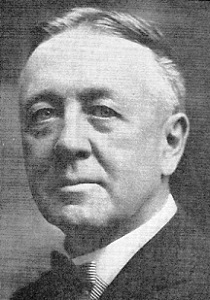
Walter S. Hibbard U.S. Military Telegraph Line 
In a column by Donna Hunt dated April 25, 2012 for the Herald Democrat,
she relates the news from Mr. Joe Obert of Montrose, Colorado that he,
while out metal detecting in the area of an old Calvary fort outside of
Montrose, had dug up what appeared to be soldier's dog tags with "W.S.
Hibbard, Denison, Texas" engraved on them. Having found no
information indicating that Mr. Hibbard had ever served in the
military, she ended her article with the following request:
"If anyone has any idea how Hibbard's dog tag got to Montrose, Colorado, Obert and I would like to know to solve the mystery. It would almost be impossible for there to be two W.S. Hibbards from Denison, texas at the fort other than our bank president, mayor and early day civic leader." Just short of four years later, the mystery has been solved. So far as anyone knew, Mr. Hibbard had not served in the military. After searching for his military records, looking at the Grayson County TXGenWeb site, Johnson & Winkler's 1914 A History of Texas and Texans and the 1947 obituary, Jim Sears found a small 4-line notice in the Denison Daily News that began to unravel the almost 136 year old mystery. 
His 1947 obituary says that he learned the art of telegraphy at an early age. By the time he graduated from high school in Denison in 1878 he would have been well-qualified for his dual employment in the telegraph departments of the M-K-T and Houston & Texas Central railroads. After a year with the railroads. he resigned his position in June 1879. The Denison Daily News reported the following month that he had been elected secretary of the Lees, a new baseball club organized to compete with the Denison Blue Stockings. Two months later, presumably after the end of baseball season, he was preparing to take charge of an office of the military telegraph line somewhere in the Indian Territory. The military telegraph system also had an office in Denison. It was established in late 1874. In 1910 B. C. Murray, editor, wrote about it in one of his "Little Stories" in The Sunday Gazetteer. The line extended from Denison to points south and west, as well as to Fort Sill in the Indian Territory. Walter Hibbard would have been familiar with the Denison office. Perhaps he even hung out there in his spare time, honing his skills in telegraphy. As noted in Donna Hunt's story of nearly four years ago, Hibbard's listing in the 1880 US Census appears to be inconsistent with his serving in the military that year. He is shown living with his parents on Woodard Street and clerking in the family grocery. The family was enumerated on June 4, 1880. I cannot account with certainty for that discrepancy. The newspaper articles place him in the Army in the Indian Territory before and after that date. Perhaps whoever was interviewed by the census taker at the family home on Woodard Street believed they should include Walter's name because Denison was still considered to be his permanent home. 
Another snippet from the Denison Daily News, dated early August 1880, reports that Walter "will return home next week" from his post at Cantonment in the Indian Territory. A cantonment is any temporary encampment for troops, but Cantonment with a capital "C" was a specific place. Established in the spring of 1879, it was on the North Canadian River, about halfway between Fort Reno and Fort Supply. It may or may not have been the location of the same telegraph office that Hibbard had taken charge of the previous September. 
The map below shows both operational and abandoned military telegraph lines in mid-1885. 
Hibbard's post in Northwestern Indian Territory was no great distance from Fort Lewis in Colorado or from the cantonment on the Uncompahgre River, about 100 miles farther north (see map). Telegraph communication between Fort Lewis and the town of Durango, about 12 miles away, was completed in September 1881. The line connecting Cantonment on Uncompahgre (renamed Fort Crawford in 1886) to the nearby town of Montrose was probably constructed not long after the Army arrived there in 1880. If Walter Hibbard participated in the construction and/or maintenance of telegraph lines in Southwestern Colorado in the early 1880s, that could account for the discovery of his dog tags on the site of Old Fort Crawford 130 years later. "This fort was established on July 21, 1880 on the west bank of the Uncompahgre River, about 4 miles north of the agency and 8 miles south of present Montrose. It was named after Emmet Crawford, who was a hero in many ways, best put as a soldier who rose through the ranks, and was killed while in pursuit of Geronimo in Mexico in 1866. The fort's purpose was to assist in the removal of the Ute Indians in the territory, and by 1881 it was complete and the Utes were already removed. At first this came while being constructed was name "Cantonment on the Uncompahgre," then in 1886 renamed Fort Crawford. Historic Forts in the State of Colorado 
I was not able to determine exactly how long Hibbard remained in the Signal Corps. After August 1880 his name does not appear in the Denison newspapers again until the spring of 1883. By that time he was back in civilian life, less than four years after his initial appointment to the Indian Territory in September 1879. For a full transcription of the above stated article, read online at The Herald Democrat.

Scottish American Roots Denison Mayors Biography Index Copyright © 2024, TXGenWeb. If you find any of Grayson County TXGenWeb links inoperable,please send me a message. |